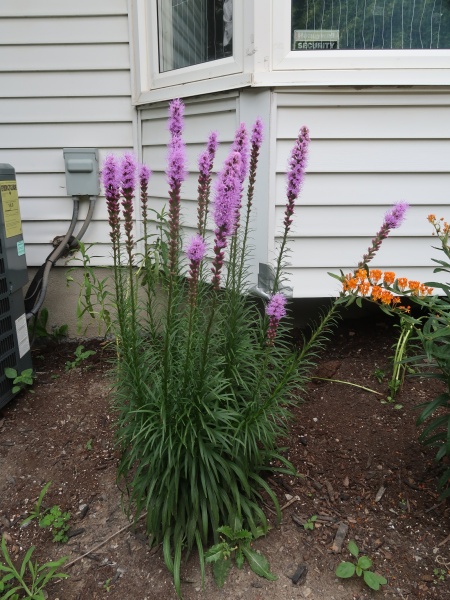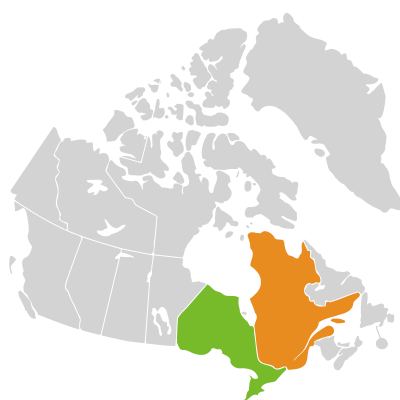
Source: OWSL
Liatris spicata
Dense Blazing Star
Liatris à épi
Synonyms
florist gayfeather
marsh blazing-star
marsh gayfeather
sessile blazing-star
sessile-headed blazing-star
Seeds in stock
Available at table Mixed Sun, Medium
Available at table Mixed Sun, Medium
We currently accept seeds for this plant
Bloom Colour: Pink
Bloom Period: Jul - Sep
Max Height: 5.0 feet
Max Width: 2.0 feet (spreads by rhizome)
Light Condition:
 More than 6 hours of direct sun a day
More than 6 hours of direct sun a day
 More than 2 or 3 hours but less than 6 hours of direct sun a day
Soil conditions:
More than 2 or 3 hours but less than 6 hours of direct sun a day
Soil conditions:
 Tolerates medium soil condition
Tolerates medium soil condition
 More than 6 hours of direct sun a day
More than 6 hours of direct sun a day
 More than 2 or 3 hours but less than 6 hours of direct sun a day
More than 2 or 3 hours but less than 6 hours of direct sun a day
 Tolerates medium soil condition
Tolerates medium soil condition
Lifespan:
Perennial
plants that will that come back year after year
Gardener Experience:
 Suitable for beginner gardeners
Suitable for beginner gardeners
 Does not spread uncontrollably
Does not spread uncontrollably
 Easy to germinate
Easy to germinate
 Self-seeding
Self-seeding
 Suitable for beginner gardeners
Suitable for beginner gardeners
 Does not spread uncontrollably
Does not spread uncontrollably
 Easy to germinate
Easy to germinate
 Self-seeding
Self-seeding
Landscape Uses:
 Suitable for rain gardens
Suitable for rain gardens
 Suitable for container garden
Suitable for container garden
 Suitable for school gardens
Suitable for school gardens
 Tolerates boulevard garden conditions
Tolerates boulevard garden conditions
 Suitable for rain gardens
Suitable for rain gardens
 Suitable for container garden
Suitable for container garden
 Suitable for school gardens
Suitable for school gardens
 Tolerates boulevard garden conditions
Tolerates boulevard garden conditions
Ecological Benefits:
 Supports birds
Supports birds
 Supports pollinators
Supports pollinators
 Butterfly host
Butterfly host
 Supports birds
Supports birds
 Supports pollinators
Supports pollinators
 Butterfly host
Butterfly host
Tolerates:
 Tolerates limestone conditions
Tolerates limestone conditions
 Tolerates sandy conditions
Tolerates sandy conditions
 Tolerates transplantation
Tolerates transplantation
 Tolerates limestone conditions
Tolerates limestone conditions
 Tolerates sandy conditions
Tolerates sandy conditions
 Tolerates transplantation
Tolerates transplantation
Special Features and Considerations:
 This plant is endangered
This plant is endangered
 This plant is endangered
This plant is endangered
Plant Location
Distribution according to VASCAN

Ephemeral
Native
Introduced
Excluded
Extirpated
Doubtful
Absent
Thrives in Ecozones
- Mixed Wood Plains
Ecological Benefits
Butterflies Supported by Liatris spicata
No butterfly data available for this plant.
Specialized Bees Supported by Liatris spicata
No bee data available for this plant.
Plants that grow in similar conditions, that bloom at the same time.
Complementary Plants
- Anaphalis margaritacea
Pearly Everlasting
Immortelle blanche - Asclepias tuberosa
Butterfly Milkweed
Asclépiade tubéreuse - Monarda fistulosa
Wild Bergamot
Monarde fistuleuse - Rudbeckia hirta
Black-eyed Susan
Rudbeckie hérissée - Schizachyrium scoparium
Little Bluestem Grass
Barbon à balais
Substitute For Non-Native Plants
- Perovskia Atriplicifolia (Russian Sage)
- Buddleia (Butterfly Bush)
- Lavandula (Lavender)
- Hesperis matronalis (Dame Rocket)
- Liatris (Blazing Star Cultivar)
Sowing Information
Download Seed Envelope Labels (PDF)
- Sowing depth: Sow just below surface
- Sow by February
- Stratification duration: 60 days
- Self-seeding
Harvesting and Seed Sharing
- Harvest start month: September
- Harvesting indicator:
- Seeds have become fluffy and can be easily removed by shaking on gently pulling off from stem
- Harvesting:
- Shake seed head in paper bag
- Seed viability test:
- No test needed before donating
- Packaging measure: 1 rounded 1/4 teaspoon
- Seed storage:
- Air dry in paper bag or open container, for a few days until crisp
- Shake seeds to move them once in a while to prevent molding
- Cultivar: Yes, do not donate unless you know source, and there are no known cultivars in your garden or at proximity
- No harvesting video available at this time.
Toxicity Notes
Inadequate information on toxicity found.


 Canadensis
Canadensis
